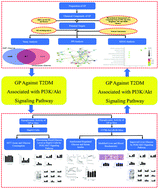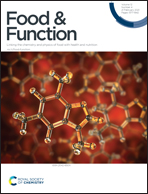Exploring the protective effect of Gynura procumbens against type 2 diabetes mellitus by network pharmacology and validation in C57BL/KsJ db/db mice†
Abstract
Gynura procumbens (Lour.) (GP), which is an edible herb, has been shown to have prominent anti-hyperglycemic activity. Nevertheless, the complex chemical composition of GP has impeded clarification of the molecular mechanisms of its effects on type 2 diabetes mellitus (T2DM). In this study, we adopted a network pharmacology approach for the exploration of the potential mechanisms of GP on T2DM. The results suggested that the PI3K/Akt signaling pathway plays a momentous role in the effects of GP. Therefore, we further investigated the effects of GP on T2DM and the mechanism of action based on the PI3K/Akt signaling pathway. In vitro experiments showed that GP ameliorated insulin resistance (IR) and glucose metabolism, thus indicating marked hypoglycemic activity. In vivo experiments showed that blood glucose, liver damage, and insulin sensitivity were ameliorated by GP intervention. Furthermore, the results of RT-PCR and western blot analyses revealed that GP regulated IR and glucose metabolism via the PI3K/Akt signaling pathway. In summary, these results indicate that GP intervention ameliorates T2DM by activating the PI3K/Akt signaling pathway.



 Please wait while we load your content...
Please wait while we load your content...